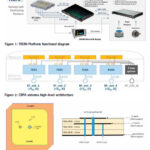Volume 21, Issue 6, June 2025 |
|
|||||||||||||||||||||||||||||||
|
|||||||||||||||||||||||||||||||
Volume 21, Issue 5, May 2025 |
|
|||||||||||||||||||||
ComNav Technology has introduced a new product called Venus Laser RTK, which allows positioning without the need for a range pole.
For the prism-free total station, the principle behind this technology is that the laser beamer on the total station sends a laser pulse towards an object and measures the time taken for the pulse to …

This paper presents the TRENI railway GNSS receiver and antenna development, to be used directly or integrated in a train multi-sensor safe positioning platform, suitable for railway safety-related applications
Marco Puccitelli
Thales Alenia Space Italia., Via E. Mattei 1, 20064 Gorgonzola (Milan), Italy
Chiara Manno
Thales Alenia Space Italia., Via E. Mattei 1, 20064 Gorgonzola (Milan), Italy
Livio Marradi
Thales Alenia …

This paper offers a state-of-the-art review of several proposed methods for interference detection and mitigation with solutions ranging from traditional to machine learning-based approaches.
Arul Elango
Department of Computer Science, University of Helsinki, Finland
Ahmed Al-Tahmeesschi
Department of Computer Science, University of Helsinki, Finland
Mikko Saukkoriipi
Department of Computer Science, University of Helsinki, Finland
Titti Malmivirta
Department of Computer Science, University of Helsinki, …

A clear, methodical and scientific distinction needs to be drawn between land use and land cover, especially in the context of urban planning and development
Dr Mahavir
Former Professor and Dean (Academic), School of Planning and Architecture, New Delhi, India
Dr Prabh Bedi
CEO, Resonance Integrated Solutions Canada Inc., Canada
The geospatial industry got another impetus from Government of India …
STMicroelectronics’ ST87M01 ultra-compact and low-power modules combine highly reliable and robust NB-IoT data communication with accurate and resilient GNSS geo-location capability for IoT devices and assets. The fully programmable, certified LTE Cat NB2 NB-IoT industrial modules cover worldwide cellular frequency bands and integrate advanced security features.
As one of the first IoT cellular products worldwide offered …






 (5.00 out of 5)
(5.00 out of 5)





 (5.00 out of 5)
(5.00 out of 5)





 (5.00 out of 5)
(5.00 out of 5)





 (5.00 out of 5)
(5.00 out of 5)